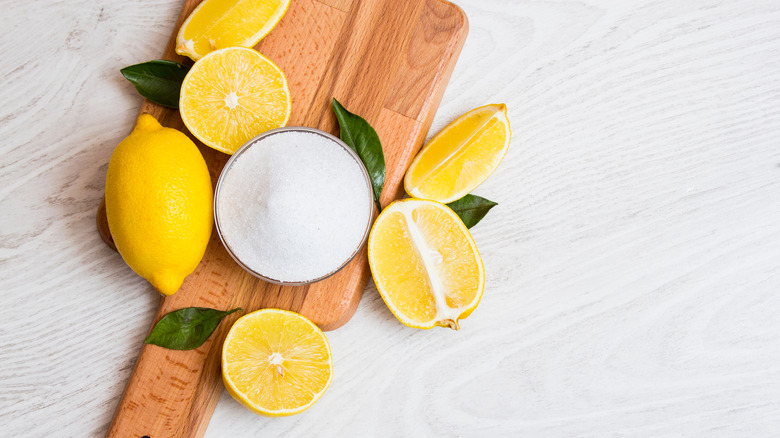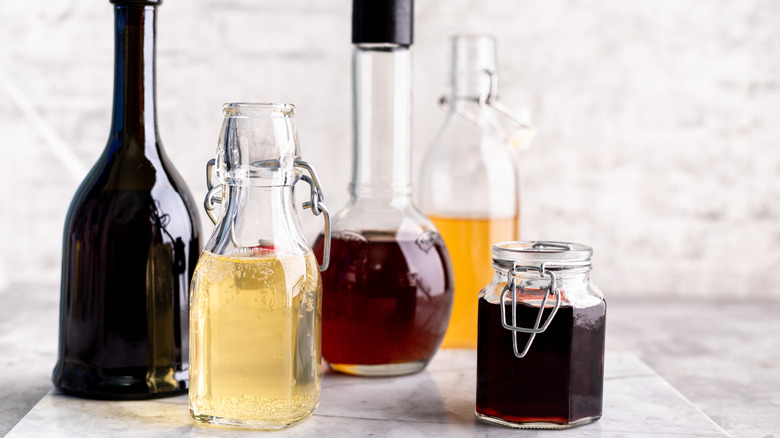The 3 Types Of Sour Professional Tasters Recognize (& So Can You)
You don't need to be a professional taster to develop your culinary palate and learn to describe differences in the elements and flavors of food. While professional tasters have honed their abilities to note nuances in recipes and find the exact words to explain how a variety of dishes taste, you can acquire similar skills at home. Most importantly, you'll need to have the right vocabulary to help you describe what you taste.
From labeling foods with sweet and savory flavors to describing tastes as mild or sharp, professionals like wine sommeliers and culinary school graduates have undergone training in order to taste, smell, and label specific flavors. Taste expert Beth Kimmerle explained to Wired that even within the term "sour," professionals have distinct categories to describe food groups. In total, three types of sours can refer to three different kinds of flavors, and we're here to help you describe your next pucker-inducing food experiences with greater accuracy.
Basic sour
Sour, one of the basic tastes, can be categorized by pH levels, but the pH index doesn't necessarily help taste testers classify and describe the taste of foods. Sour tastes are commonly used to describe acidic foods and drinks, ranging from lemons to yogurts to beers. For carbonated soft drinks and beers — drinks with low pH levels — some element of sour is present; too much sour taste, however, can impact the classification of the product itself.
Sour tastes are affected by the acids present in the food itself. Receptor cells on the tongue are triggered by hydrogen ions from the acids in the object being tasted. Take water, a neutral solution, meaning it has an equal number of hydrogen and hydroxide ions. For a drink or food to be detected as sour, like in acidic and citrus-like flavors, more hydrogen ions must be present than hydroxide ions. The more acidic a food is, the more hydrogen ions trigger those sour taste receptors on the tongue. But as Kimmerle explains, there are two other categories that professional testers use to designate sour-tasting ingredients.
Lactic sour
The lactic sour flavor profile is a kind of sour that is most commonly detected in yogurts, sour milks, and some beers. In beers, lactic acid bacteria from the brewing process helps certain brews tick the box of this unique flavor description. Particularly, for many stouts and ales, the lactic sour description can be a positive characteristic and doesn't mean the taste is off, whereas describing another kind of brew as sour might negatively indicate the poured pint came from a spoiled batch.
To develop your ability to recognize and label this kind of lactic sour taste, you'll find that lactic acid is easy to notice when sampling sour beers. Sour beers are distinctly acidic and lively on the tongue. Similarly, this same lactic sour flavor can be present in certain dairy products like cheeses and kefir, resulting in a tangy flavor that is noticeable but not revolting. In short, the lactic sour description is used to label foods and drinks that are mildly sour to taste.
Acetic sour
The final group of sour flavor categories is attributed to fermented products. Acetic sour is most noticeable in fermented beverages and astringent vinegars. Some coffee varieties can also offer this acetic flavor profile. Often, this sour category is accompanied by pungent aromas, and you may be able to quickly detect the distinction with vinegars and kombucha. In more concentrated doses, highly acetic sours can be irritating to the eyes and the nose.
Practice cultivating your tasting skills by comparing a line up of food and drinks while trying to describe the flavors and tastes you experience. To develop your ability to recognize the different categories of sour, contrast kimchi, balsamic vinegar, citrus fruits, unsweetened yogurt, and either a kombucha or sour ale. As you familiarize yourself with the different tastes, you'll have an easier time recognizing and noting which concoction falls into which category of sour. With enough practice, you'll make an expert like Beth Kimmerle proud with your astute culinary observations.



